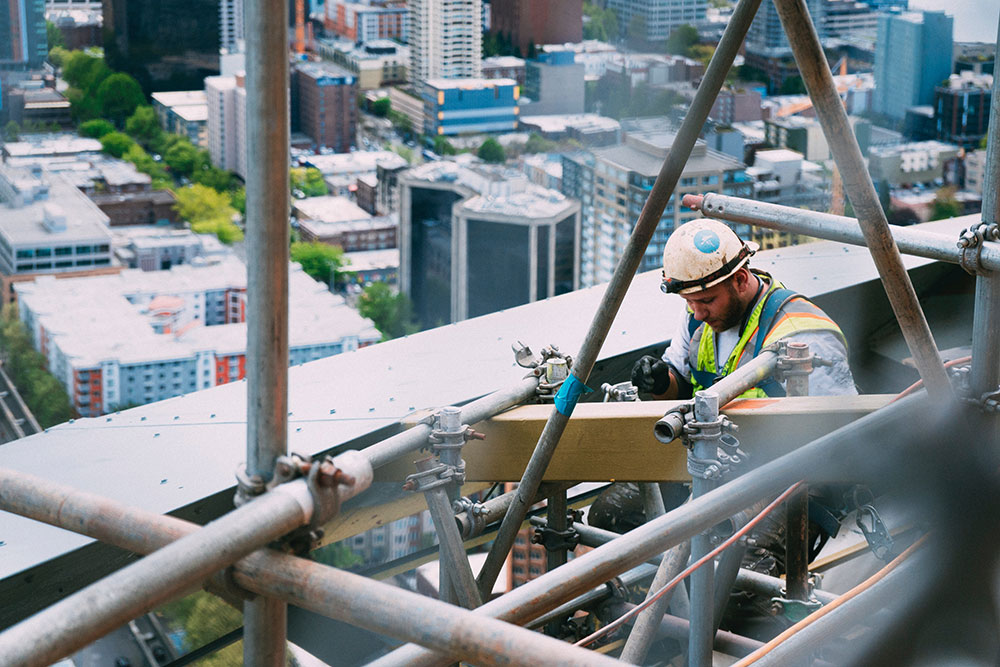Working from heights VR simulations
VR simulations offer a cost-effective and immersive way to train employees in safety procedures. Working from heights VR simulations are simple: they involve a VR headset and hand controllers and use VR environments to recreate real-world scenarios for training purposes.
VR simulations have also been shown to be effective at teaching hard skills (such as how to use specific equipment) and soft skills (such as how to communicate with co-workers).
VR group training simulations are also an ideal way to onboard new employees or train groups of employees in VR environments. Here are four benefits of this type of training:
1. It’s immersive
Virtual Reality (VR) simulations provide a realistic and immersive experience which can help to familiarise workers with the environment. This in turn can build their confidence and understanding of the need to stick to the procedure, thus minimising any potential risks.
The best part of these simulations is just how customisable they are. Companies or individual workers can tailor training according to their needs, ensuring employees get the most beneficial outcome from their tuition.
As a result, VR simulations have become an invaluable resource for anyone looking to develop safe working practices; allowing for a deeper comprehension of any associated hazards.
2. It’s interactive
Virtual reality (VR) simulations have opened the door to endless possibilities in training and education. Businesses can create realistic scenarios which allow employees to experience job-related tasks safely but in an engaging way.
For example, workers can learn effective ways to work from heights or in hazardous environments without being exposed to actual risks. VR simulations are an efficient way of teaching safety protocols as they offer a more immersive and interactive learning process than traditional education methods.
Ultimately, this makes it easier for employees to remember and absorb important information while having fun with the training process.
3. It’s adaptable
Working at heights carries with it inherent risks, but the development and use of virtual reality simulations help to reduce these risks by giving workers the chance to practice in a secure and managed environment.
This process requires close collaboration between organisations and VR instructors; by working together, we can develop a virtual reality experience that is customised to each organisation’s specific needs, so that Australian workers can gain the necessary skills and understanding for working safely near elevated levels.
Consequently, organisations are able to provide their staff with greater confidence, safety and security when undertaking such tasks.
4. It’s convenient
VR is rapidly becoming an essential tool for businesses across a range of industries. From VR training and VR education to VR workforce development and VR safety training, VR is being used to increase efficiency, improve outcomes and prepare employees for the future. 3D Walkabout is at the forefront of this VR revolution, utilising the latest technology to create awe-inspiring VR experiences that engage, educate and entertain.
Our team of VR developers, AR developers and CGI artists are experts in creating VR content that delivers results. Whether you’re looking to promote your brand or train your employees we can help.
Summary: How can VR simulations be used for working at heights?
VR simulations provide cost-effective safety training for working at heights.
Simulations enhance hard and soft skills through immersive experiences.
Customisable scenarios adapt to organizations’ specific needs for effective training.
VR simulations offer interactive learning, improving retention of safety protocols.
VR technology is convenient and applicable in various industries for workforce development.
FAQs
Is VR training cost effective?
When it comes to training and education, virtual reality (VR) can be a cost-effective alternative to traditional classroom lectures. VR lets students experience a real-life scenario in a safe environment that’s not only more engaging but also more cost-efficient.
Is VR training good?
Virtual reality (VR) training is a great way to train employees. It can be used for training employees on how to use a specific piece of equipment or software, as well as teaching them how to perform their jobs in the real world. It’s also useful for educating employees on how to handle a new situation or scenario.
How virtual reality is used in training?
Virtual reality is used in training to simulate real-world situations. It can be used to train a variety of skills, from operating heavy machinery to flying an aeroplane. This is accomplished by using a headset that has built-in headphones, which allow the user to hear what’s going on around them. The headset also blocks out all other sounds.
How do you start virtual reality training?
The first step in virtual reality training is to decide what kind of experience you want to provide your employees with. Do you want them to have an immersive experience with 3D visuals? Do you want them to feel like they’re there? Or do you just want them to learn how different tools work?
What is virtual reality training?
Virtual reality (VR) training is a way to train employees using computer-generated environments that mimic real-world situations. These environments can be created with video game engines or 3D modelling software, and they can be used to simulate any number of scenarios.


